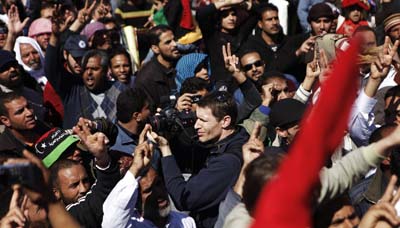Stop the bleeding. It’s a critical and fundamental step in aiding a journalist or anyone wounded in conflict. Hemorrhage is the number one preventable death on the battlefield. And yet large numbers of journalists covering wars and political unrest all across the world are untrained in this life-saving skill. It doesn’t need to be that way.
As deputy director of Reporters Instructed in Saving Colleagues (RISC), I was asked by CPJ to prepare an internal report on the medical needs of conflict journalists. RISC was founded by journalist Sebastian Junger after his close friend and colleague, the acclaimed photojournalist Tim Hetherington, died in Libya in April 2011 from wounds sustained in a mortar attack. Our nonprofit organization provides specialized battlefield first-aid courses free of cost to freelance conflict journalists. CPJ was an early sponsor of RISC and continues to support the project.
After researching casualties among conflict journalists and the hostile environment training programs available in the profession, it became clear to me that the need for such first-aid training among conflict journalists, particularly freelancers, is far from being met.
CPJ data show that gunfire and exploded ordnance (including mortars, missiles, improvised explosive devices, suicide bombs, and grenades) are the main causes of combat deaths among journalists. But wounds sustained from these weapons are not always fatal if someone is able to slow or stop the bleeding until the injured person reaches professional medical care. Reporters often travel in groups to stay safe, but few have been trained in this most basic skill–one that can save the lives of their colleagues.
“Tim’s wound did not have to be fatal, but it killed him nevertheless,” said Junger, who spoke with a combat medic after Hetherington’s death. “His femoral artery had been cut, and although that is an extremely serious injury, there are things that can be done to prolong life. Unfortunately, none of the journalists or rebels around him knew what to do, and Tim bled out and died in the back of a pickup truck on the way to the Misurata hospital.”
While most news organizations train their employees before sending them to cover conflict, many also rely on the work of freelancers, the vast majority of whom are untrained. The cost of traditional hostile environment training is prohibitive for most freelance journalists. I interviewed 12 journalists for my report, nine of whom were freelancers. Almost all had little or no first-aid training. Most said they didn’t know colleagues who had been trained. No one had even heard of a freelancer being formally trained.
“It’s just not the norm,” said Jon Lee Anderson, a writer for The New Yorker who has covered combat zones as a freelancer since the early 1980s. One freelance photographer I spoke to said that most journalists she knows show up to war zones “wildly unprepared.” Journalists with little field experience or training flooded into restive countries across the Middle East and North Africa in 2011 because access was often easy and many of the popular uprisings started relatively peacefully. Since the Tunisian revolution in December 2010, at least 21 journalists have been killed in the region while covering combat or dangerous assignments such as street protests.
It’s not as if freelancers spurn the opportunity for first-aid training. On the contrary: The demand far outstrips the supply. Just one month after opening registration for our battlefield first-aid courses, RISC had received nearly 200 applications from freelance conflict journalists around the world who were eager to be trained. Many applicants had been reporting in conflict zones for years without any form of training, and several cited the high cost of hostile environment courses.
One applicant said he had been trained in the past, but it was “horribly expensive” and he had put off renewing his certification because of the cost. Another said she had long wanted to participate in training, but the costs are “far beyond my budget as a freelancer.”
There are a few organizations that provide support to journalists who want to participate in security training or borrow safety equipment. The Rory Peck Trust, which was established in memory of the freelance cameraman killed while filming in Moscow in 1993, offers both monetary and in-kind resources to freelancers for security trainings. Reporters Without Borders offers free, basic first-aid kits and two-month loans of body armor, helmets, and personal distress beacons.
The journalist security field is evolving, as illustrated in CPJ’s new guide for reporters. Hostile environment courses, once focused on coverage in traditional war zones, have broadened in scope in recent years to adapt to the changing nature of conflict. The International News Safety Institute has worked with local governments and organizations to develop country-specific training. Other training programs have developed curricula tailored for coverage of civil unrest, terrorism, and organized crime, along with addressing sexual assault and the emerging risk of digital surveillance.
The safety of conflict journalists has gained prominence in the past year as a number of well-known correspondents, both staff and freelance, died while covering the Middle East unrest: The deaths of Marie Colvin, Anthony Shadid, Tim Hetherington, and Chris Hondros underline the need for a greater understanding of how fatalities can be minimized. There is also room for more debate on the legal and ethical responsibilities that news organizations ought to bear in preparing the freelance journalists who work for them from the front lines.
In the meantime, we can start with a basic step: Train conflict journalists to stop the bleeding.
